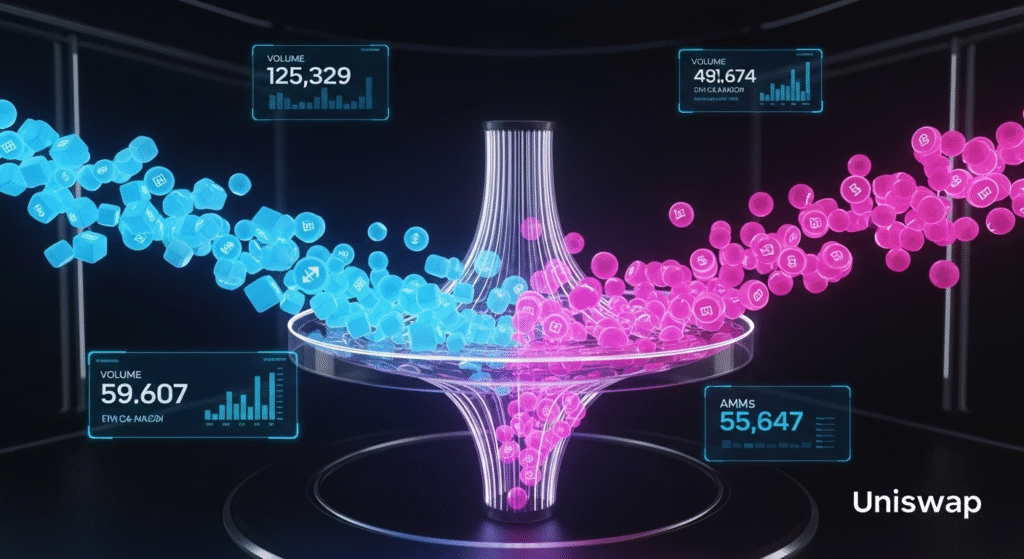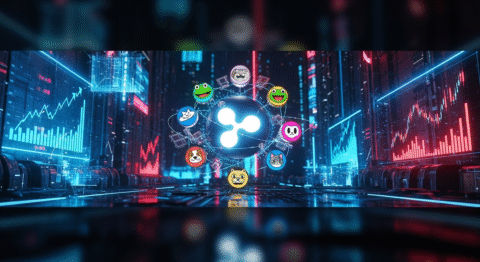.
How many times have you scrolled through crypto news, dreaming of spotting that next 100x coin before it explodes, only to end up chasing volatile pump-and-dumps? The decentralized exchange (DEX) landscape, particularly on Ethereum, is a vibrant, albeit wild, frontier for discovering early-stage cryptocurrency projects. For those looking to profit from the next wave of innovation, mastering Uniswap Trading is no longer just an option; it’s a necessity. But how do you sift through thousands of tokens to find those elusive 5x altcoin gems, avoiding the rug pulls and dead ends? This guide will equip you with the data-driven insights and strategic approaches to navigate Uniswap and unearth potentially high-growth altcoins, including those burgeoning Uniswap Altcoins.
The allure of finding that next big altcoin is undeniable. Stories of early investors turning small sums into fortunes by investing in nascent projects before they hit mainstream exchanges fuel the imagination. Platforms like Uniswap, the leading Decentralized Exchange (DEX) on the Ethereum network, have become breeding grounds for these potential breakthroughs. However, the sheer volume of new tokens launched daily can be overwhelming. Without a systematic approach and a keen eye for data, it’s easy to get lost in the noise.
Crypto Market Overview: Riding the Altcoin Wave
The cryptocurrency market is a dynamic ecosystem, perpetually evolving with new trends and narratives. Currently, we’re witnessing a significant resurgence in altcoin interest, often driven by specific technological advancements, upcoming network upgrades, or potent cultural trends like meme coins. Bitcoin and Ethereum still set the broader market sentiment, but it’s often the alternative coins – the altcoins – that offer the most explosive growth potential.
Key indicators we’re tracking include Bitcoin dominance (which, when falling, often signals a strong altcoin season), Total Value Locked (TVL) across various DeFi protocols (indicating capital flowing into the decentralized economy), and social media sentiment analysis (often an early indicator for meme coins and new trends). Recent market movements have shown significant rallies in specific altcoin sectors like Layer 1 alternatives, Layer 2 scaling solutions, AI-integrated tokens, and, of course, the ever-present meme coin phenomenon. Airdrops also continue to be a popular method for distributing tokens and generating early community engagement.

The Core Concept: How Uniswap Trading Actually Works
To effectively trade on Uniswap and find those 5x altcoin gems, it’s essential to understand the foundational elements of decentralized exchanges and the tokens you’ll encounter.
What Are Altcoins / Meme Coins / Airdrops?
Altcoins is a broad term that refers to any cryptocurrency other than Bitcoin. They emerged as developers sought to improve upon Bitcoin’s perceived limitations or to explore entirely new use cases for blockchain technology. This can range from smart contract platforms like Ethereum to privacy-focused coins, stablecoins, and utility tokens.
Meme Coins are a sub-category of altcoins that often derive their value from internet memes, social media trends, and community hype rather than underlying utility or fundamental development. While many meme coins fail to maintain long-term value, some have achieved significant market capitalization due to strong community backing and viral marketing. Examples include Dogecoin and Shiba Inu, which, despite their meme origins, have developed substantial ecosystems and communities.
Airdrops are a marketing strategy used by blockchain projects to distribute their tokens to the community. This often involves rewarding existing holders of certain cryptocurrencies or users who complete specific tasks (like interacting with a new protocol) with free tokens. Airdrops can be a way to gain early access to a project’s native token, sometimes before it’s widely available for trading.
Key Components & Technologies
The foundation of Uniswap and most altcoins lies in blockchain technology. This distributed ledger technology ensures transparency, security, and immutability. Uniswap, specifically, operates on the Ethereum blockchain, which is renowned for its smart contract capabilities. These smart contracts automate agreements and transactions without intermediaries.
Uniswap utilizes an Automated Market Maker (AMM) model, which is a departure from traditional order-book exchanges. Instead of matching buyers and sellers directly, AMMs use liquidity pools. Users deposit pairs of tokens into these pools (e.g., ETH and a new altcoin), and transactions occur against these pools. The price is determined by a mathematical formula, typically x * y = k (constant product formula), where x and y are the quantities of the two tokens in the pool, and k is a constant. As one token is bought, its supply in the pool decreases, and its relative price increases. This model enables continuous liquidity, meaning tokens can be traded at any time, provided there is liquidity in the pool.
Key technologies powering these altcoins often include:
- Smart Contracts: For programmable transactions and decentralized applications (dApps).
- Token Standards: Such as ERC-20 on Ethereum, which defines how tokens are created and managed, ensuring interoperability.
- Decentralized Finance (DeFi): Altcoins are often the building blocks of the DeFi ecosystem, enabling peer-to-peer lending, borrowing, trading, and staking.
The Data-Driven Perspective: Unearthing Value on Uniswap
Successfully navigating Uniswap for 5x gains requires a data-centric approach, moving beyond pure speculation.
Market Data & Trends
When analyzing potential altcoins on Uniswap, several data points are critical:
- Trading Volume: High trading volume indicates active interest and liquidity. A sudden surge in volume for a token with low initial liquidity can signal an early breakout. Look at 24-hour and 7-day volumes.
- Liquidity: Sufficient liquidity is crucial for seamless trading and to minimize slippage (the difference between the expected price and the executed price). A healthy liquidity pool, often measured in USD value, indicates that traders are willing to stake their assets.
- Market Cap: While nascent tokens may have small market caps, understanding the potential market cap based on comparable projects can be insightful. A low market cap with strong fundamentals has more room for exponential growth.
- Price Charts & Trading History: Analyze price action, support/resistance levels, and identify any patterns. Tools like DexScreener, DEXTools, or charting platforms integrated with Uniswap data are invaluable here.
- Transaction Data: On-chain data can reveal significant activity. Look for large buy orders, the number of holders, and the distribution of tokens (e.g., is it concentrated in a few wallets?).
Data Insight Example: Imagine a newly launched token showing a steady increase in daily trading volume over a week, accompanied by a growing number of unique holders, and its price is consistently holding its gains against the ETH/token liquidity pool. This pattern suggests accumulating interest and a healthy demand, making it a candidate for further investigation as a potential 5x gem. Conversely, a token with sporadic, high volume followed by sharp drops and a declining holder count might be a pump-and-dump scheme.
Tokenomics & Market Health
Tokenomics refers to the economic design of a cryptocurrency, influencing its supply, demand, distribution, and overall utility. Analyzing tokenomics is paramount to assessing long-term value.
- Total Supply & Circulating Supply: A capped total supply can create scarcity, potentially driving up prices if demand increases. A rapidly inflating supply can dilute value.
- Distribution: How are tokens distributed? Are they concentrated in the hands of a few early investors or the development team (pre-mine or large allocation)? For a healthy project, a wider distribution among users and the community is generally preferred, with a reasonable portion for the team and advisors that is often vested over time.
- Utility: Does the token have a clear purpose within its ecosystem? Does it grant access to services, enable governance, or function as a medium of exchange? Tokens with strong utility tend to be more sustainable.
- Token Burn Mechanisms: Some projects implement token burns, permanently removing tokens from circulation, which can reduce supply and potentially increase scarcity.
- Staking & Yield Generation: Does holding the token offer any rewards or passive income opportunities? This can incentivize long-term holding and reduce sell pressure.
Data Insight Example: A project with a tokenomics model that includes a clear utility (e.g., the token is required to access premium features of their platform), a fixed total supply, a deflationary burn mechanism, and a distribution plan where team tokens are locked for 2-3 years, presents a stronger case for long-term growth than a token with an infinite supply, no clear use, and immediate unlocking of team tokens. For instance, analyzing the Smart Contract details on Etherscan can reveal crucial information about token burns or any potential “honeypot” functions (where buying is allowed but selling is not).
Risks, Challenges & Competition
Despite the potential for massive gains, trading altcoins on Uniswap is fraught with risks.
Risks of Altcoins and Meme Coins
- Extreme Volatility: Altcoins, particularly new ones and meme coins, are notorious for dramatic price swings. They can surge hundreds or thousands of percent and then crash just as quickly.
- Rug Pulls & Scams: The ease of launching tokens on Uniswap has also attracted malicious actors. A “rug pull” occurs when developers abandon a project, taking investors’ funds with them, often by removing liquidity or selling their accumulated tokens.
- Lack of Liquidity: Many new tokens have very thin liquidity, meaning even small trades can cause significant price changes (slippage). This also makes it difficult to exit positions without substantial losses.
- Technical Failures & Smart Contract Vulnerabilities: Bugs or exploits in a token’s smart contract can lead to loss of funds.
- Regulatory Uncertainty: The regulatory landscape for cryptocurrencies is still evolving, which can affect the legitimacy and future of many altcoins.
- Information Asymmetry: Early information is often scarce, and discerning genuine projects from hype can be challenging.
How Does Uniswap Trading Stack Up Against Competitors?
When considering decentralized trading, Uniswap is a dominant player, but understanding its position relative to other DEXs and even centralized exchanges (CEXs) provides context.
| Feature | Uniswap (Ethereum) | Binance Smart Chain (BSC) DEXs (e.g., PancakeSwap) | Centralized Exchanges (CEXs) (e.g., Binance, Coinbase) |
|---|---|---|---|
| Decentralization | High (AMM, non-custodial) | High (AMM, non-custodial) | Low (Custodial, relies on intermediaries) |
| Liquidity | Very High (especially for major tokens), but gas fees can deter small trades. | High, generally lower fees than Ethereum. | Very High, deep order books. |
| Gas Fees | Can be very high, especially during network congestion. | Significantly lower than Ethereum. | Usually integrated into trading fees. |
| Accessibility | Easy to access with a Web3 wallet (MetaMask). | Easy to access with a Web3 wallet. | Requires KYC/AML verification and account creation. |
| Token Variety | Vast, almost any ERC-20 token can be listed. | Vast, any BEP-20 token can be listed. | Curated list, often only established projects. |
| Launchpad/New Tokens | Very easy for new tokens to launch, high risk of scams. | Very easy for new tokens to launch, high risk of scams. | Rigorous listing process, harder for new tokens. |
| User Experience | Can be complex for beginners (managing gas, slippage). | Generally more user-friendly than ETH DEXs. | Typically the most intuitive and user-friendly. |
Data Insight Example: If your primary goal is to trade the absolute newest, potentially unproven tokens with the highest upside, Uniswap and BSC DEXs are the places to look due to their open nature. However, if you prioritize lower transaction costs and a more predictable trading environment, trading established altcoins on a CEX might be preferable. For those seeking an early entry into a promising project before it lists on major CEXs, advanced Uniswap trading is the path, but it demands greater vigilance and research due to the increased risk.
The Future Outlook: What’s Next for Altcoins and DEXs?
The landscape of altcoin trading, particularly on platforms like Uniswap, is far from static. Several trends suggest an exciting, albeit complex, future:
What’s Next for Altcoins / Meme Coins / Airdrops?
- Increased Sophistication of Scams: As detection methods improve, scammers will likely become more elaborate in their tactics. This will necessitate even deeper due diligence from traders.
- Rise of Layer 2s and Interoperability: As gas fees on Ethereum remain a concern, more new tokens and trading activity will likely migrate to or utilize Layer 2 scaling solutions (like Arbitrum, Optimism) and cross-chain bridges. This will create new opportunities and complexities in tracking liquidity and price.
- Focus on Utility and Sustainability: While meme coins might continue to have their moments, there’s a growing demand for altcoins with tangible utility, strong development teams, and sustainable tokenomics. Projects that solve real-world problems or innovate in sectors like AI, DeFi, or gaming are likely to see sustained interest.
- AI Integration: Artificial intelligence is increasingly being integrated into blockchain projects, from predictive analytics for trading to AI-powered decentralized applications. Tokens associated with these emerging sectors could see significant growth.
- Regulatory Clarity (Potential): As governments worldwide grapple with regulating cryptocurrency, clearer frameworks could emerge. While this might temper some of the wilder speculation, it could also legitimize the market and attract more institutional capital to promising altcoins.
- Airdrop Sophistication: Airdrops will likely remain a key growth lever, but projects may become more discerning about who receives them, focusing on genuine network participation rather than bot farms.
For those engaging in Uniswap Trading, staying ahead means constantly adapting to these shifts. This includes continuously monitoring new token launches, understanding evolving investor sentiment, and leveraging advanced analytics tools. The potential for significant returns on Uniswap Altcoins remains, but the path requires diligence, a data-driven mindset, and a healthy respect for the inherent risks.
Conclusion
Finding 5x altcoin gems on Uniswap is an ambitious but achievable goal for well-prepared traders. It requires more than just luck; it demands a blend of technical understanding, market analysis, and a rigorous risk management strategy. We’ve explored the core mechanics of Uniswap, the nature of altcoins and meme coins, and the crucial data points you need to analyze, from trading volume and liquidity to the intricacies of tokenomics.
Remember, the decentralized exchange landscape is a frontier where innovation meets high risk. By focusing on data-driven insights, understanding tokenomics, remaining vigilant against scams, and staying informed about market trends, you can significantly improve your chances of identifying promising projects and capitalizing on their growth.
What are your favorite tools for discovering new altcoins on Uniswap? Do you have any strategies for spotting early gems that you’d like to share? Let us know in the comments below!
For more insights into navigating the fast-paced world of cryptocurrency, be sure to explore our other articles on DeFi strategies and altcoin analysis. Don’t forget to subscribe to our newsletter for the latest updates and trading tips!
FAQs
Q1: How can I find new altcoins launching on Uniswap?
You can find new altcoins using platforms like DexScreener, DEXTools, Token Sniffer (for scam detection), and by monitoring crypto news outlets and forums. Many projects also announce their Uniswap listing on platforms like Twitter or Discord.
Q2: What is a “rug pull,” and how can I avoid it?
A rug pull is a scam where developers abandon a project and drain its liquidity pool, leaving investors with worthless tokens. To avoid them, research the project team’s reputation, check tokenomics for signs of manipulation (e.g., large team allocations), analyze liquidity lock-up periods, and look for audit reports from reputable firms. Tools like Token Sniffer can help flag suspicious contracts.
Q3: How much ETH should I use for trading on Uniswap?
This depends on your risk tolerance and capital. Given the volatility of new altcoins, it’s generally advised to only invest what you can afford to lose. Start with smaller amounts until you gain more experience and confidence in your research process.
Q4: What are gas fees on Uniswap, and can I reduce them?
Gas fees are transaction costs on the Ethereum network, required for every interaction with smart contracts, including token swaps on Uniswap. They fluctuate based on network congestion. You can sometimes reduce fees by trading during off-peak hours or by using a Layer 2 scaling solution if the token is available there.
Q5: How important is community engagement for an altcoin’s success?
Community engagement is extremely important, especially for meme coins and newer projects. A strong, active community can drive adoption, provide support, and create buzz, all of which can contribute to a token’s price appreciation. However, it’s crucial to distinguish between genuine community support and artificial hype generated by bots.






